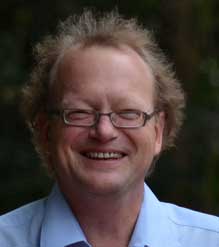The Solvay Meetings – Impact on Outreach Activities
By Prof. Alexander Sevrin
Brief History
From Monday October 30 through Friday November 3, 1911, 23 leading physicists from all over Europe met at the Hotel Métropole in Brussels to discuss about “la théorie du rayonnement et les quanta”, the theory of radiation and quanta. The initiative for this conference was taken by Ernest Solvay, a prominent Belgian industrialist with a keen interest in science, and the conference was chaired by Hendrik Lorentz.
In 1912 Ernest Solvay founded the International Institute for Physics followed in 1913 by the creation of the International Institute for Chemistry. In 1970 the Solvay family in association with the Université Libre de Bruxelles (ULB), and the Vrije Universiteit Brussel (VUB), merged both Institutes and established the “International Institutes for Physics and Chemistry, founded by Ernest Solvay”.
For more than a century the tradition of scientific excellence continued and the activities of the International Solvay Institutes greatly expanded including an important emphasis on scientific outreach.
Main Focus and Uniqueness
Today the main focus of the International Institutes for Physics and Chemistry founded by Ernest Solvay is still the organization of the International Solvay Conferences. It follows a three year cycle: in year one there is the Physics Conference, in year two there is no conference and in year three there is the Chemistry Conference. The last and 26th Solvay Physics Conference took place from October 9 through 11, 2014. Its theme was “Astrophysics and Cosmology” and it was chaired by Roger Blandford from Stanford University. The 24th Solvay Conference on Chemistry will be held in October 2016.
The Solvay Conferences on Physics are unique among physics meetings and have followed the same setup since their very inception. The Scientific Committee for Physics of the Solvay Institutes is in charge of the Conferences. The Committee consists of ten outstanding physicists appointed for a six year period, renewable once.1 It defines a theme in physics of current interest and appoints a chair for the conference.
From then on the chair assumes full responsibility. He or she drafts a list of 40 to 60 invitees, all leading experts in the theme addressed during the conference. In addition, five important questions within the theme are defined to each of which half a day is devoted. Each of these sessions is prepared by the session chair in close collaboration with the chair of the conference and starts with a brief review of the state of the art by the rapporteur. The bulk of the session is then fully devoted to a round table discussion, which makes the Solvay Conferences very different from other conferences in physics. Since the first Solvay Conference the discussions are reproduced verbatim in the proceedings thus providing a remarkable testimony on the thoughts and convictions of outstanding physicists at that given time. As an example, the last Solvay Conference on Physics held in 2014 addressed current problems in “Astrophysics and Cosmology” and the five sessions were devoted to: Neutron Stars, Black Holes, Cosmic Dawn, Dark Matter, and the Microwave Background. About 60 invited experts, coming from very different subdisciplines of astrophysics and cosmology, had over three days numerous lively, cross-fertilizing, and sometimes even contentious discussions.2
Other Highlights
While the Solvay Conferences on Physics and Chemistry remain the core business of the Solvay Institutes, numerous other initiatives are taken as well. Every year the Institutes organize four or five topical high level workshops that run over three to five days, focus on important developments in both physics and chemistry and are heavily attended by scientists from Belgium and its neighboring countries. Some topics recently covered were: Quantum Simulation with Cold Matter and Photons, Conceptual Quantum Chemistry, Bridging the Gaps at the PCB Interface - Multiscale Modeling in Physics, Chemistry and Biology, and Nonequilibrium and Nonlinear Phenomena in Statistical Mechanics.
The yearly International Jacques Solvay Chair in Physics and the International Solvay Chair in Chemistry attract eminent scientists who pass one or two months in Brussels, collaborating with the local scientists and giving Master Classes to doctoral students, postdoctoral fellows, and faculty from all over the country. The Master Class is preceded by an inaugural lecture aimed at a wider audience. The 2015 Jacques Solvay Chair in Physics was held by Peter Zoller who lectured on quantum information and quantum computing.
A monthly colloquium where hot topics are presented by eminent scientists serves the local physics and chemistry community. An extensive doctoral school “Quantum Field Theory, Strings and Gravity” is organized every year in collaboration with the ULB, the VUB, the University of Amsterdam, various institutions in Paris headed by École Normale Supérieure (EPS), and various institutions in Switzerland led by the Swiss network "SwissMap" (ETH Zürich, U. Bern, U. Geneva, CERN) providing first-year PhD students with advanced courses in theoretical physics that help bridge the gap between Master-level courses and the most recent advances in the field.
In addition to this the International Solvay Institutes contribute both logistic and financial aid to numerous scientific and outreach events in and out of Belgium.
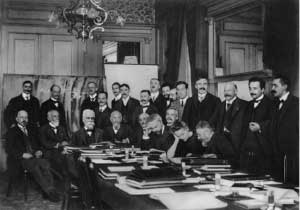
Photograph of participants of the first Solvay Conference, in 1911, Brussels, Belgium. Seated (L-R): Walther Nernst, Marcel Brillouin, Ernest Solvay, Hendrik Lorentz, Emil Warburg, Jean Baptiste Perrin, Wilhelm Wien, Marie Curie, and Henri Poincaré. Standing (L-R): Robert Goldschmidt, Max Planck, Heinrich Rubens, Arnold Sommerfeld, Frederick Lindemann, Maurice de Broglie, Martin Knudsen, Friedrich Hasenöhrl, Georges Hostelet, Edouard Herzen, James Hopwood Jeans, Ernest Rutherford, Heike Kamerlingh Onnes, Albert Einstein, and Paul Langevin
Outreach Activities
One of the absolute highlights of the activities of the International Solvay Institutes are the yearly Solvay Public Lectures that take place in the magnificent setting of Studio 4 in the Flagey Building. The Flagey Building is a beautiful edifice in modernistic style constructed from 1935 through 1938 and located on the edge of the Flagey Square and next to the Ixelles ponds in Brussels. During the Solvay Public Lectures, which started in 2005 and are usually held on a Sunday afternoon in October, distinguished scientists deliver lectures on the state-of-the-art in their field of research with an overview of the most pressing current issues.
Organized jointly with the ULB, the VUB, and the Solvay Group, this event popularizes science and aims at making it more attractive to the younger generations. The talks are given in English but simultaneous translations into Dutch and French are provided. The lectures are followed by a debate where a panel consisting of renowned scientists address questions from the audience. The event closes with a drink offered to all the participants, allowing the public to interact directly with the invited scientists. The event is free and every year the 862 seats of Studio 4 are solidly packed!
To give a flavor of the diversity of topics addressed during the Solvay Public Lectures and the excellence of the lecturers, I list the speakers and topics since the Centennial of the Solvay Institutes. In 2011 under the theme The Future of Physics, William Phillips talked on Time and Einstein in the 21st century, and Frank Wilczek on Quantum Beauty. In 2012 George Whitesides discussed The Science of Simplicity, Michael Freedman considered Will our Thinking Become Quantum-Mechanical?, and Kurt Wüthrich presented Exploring the Postgenomic Protein Universe. The next year the audience was entertained by presentations by Joachim Frank on How proteins are made in the cell: Visualizing the ribosome in action and Jason Chin on Reprogramming the genetic code. In 2014 three talks were delivered: Conny Aerts on Starquakes and Exoplanets in our Milky Way galaxy, Martin Rees on From a `simple’ big bang to our complex cosmos, and François Englert on The Brout-Englert-Higgs mechanism and its scalar boson. Last year one hundred years of Einstein’s general relativity was celebrated by talks by Reinhard Genzel on Massive Black Holes and the Evolution of Galaxies and Viatcheslav Mukhanov on From Nothing to the Universe. This years’ Public Event has Chemistry for the World of Tomorrow as its theme, and lectures by Robert Grubbs on Translation of Academic Science into the Commercial and Ben Feringa on The Art of Building Small will be delivered.
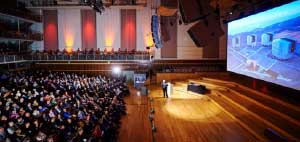
Every year again the Solvay Public Lectures attracts more than 800 interested people in the magnificent Studio 4 of the Flagey Building in Brussels. Shown here: Reinhard Genzel in 2015 talking about “Massive Black Holes and the Evolution of Galaxies
Since its start in 2005, the Solvay Public Lectures have grown into one of the most visible and popular scientific outreach events in Belgium. Its success clearly demonstrates that public outreach by physicists and other scientists is more than ever needed! As Jean-Marie Solvay, the great grand-son of Ernest Solvay and the President of the International Solvay Institutes states: “We need scientists to be heard and to be lauded, we need to show that science is a fascinating subject raising intriguing and captivating challenges, and we need to demonstrate that it is extraordinarily important for the future of humanity to pursue scientific advances, which are critical to the survival of human beings on earth. Hence our commitment to public events and lectures.”
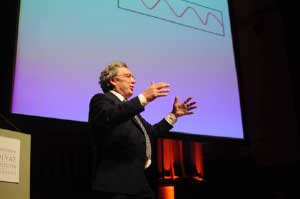
Viatcheslav Mukhanov presenting his outreach talk “From Nothing to the Universe” at the 2015 Solvay Public Event “One Hundred Years of Einstein’s General Relativity”.
The Hotel Métropole – European Physical Society (EPS) Historic Site
The Hotel Métropole was the venue of the first Solvay Council. After that both the Solvay Conferences on Physics and those on Chemistry moved to other places in Brussels (and even a few times abroad). However since the 23rd Solvay Conference on Physics “The Quantum Structure of Space and Time” in 2005 the Solvay Conferences returned to the Hotel Métropole where they are being held ever since.
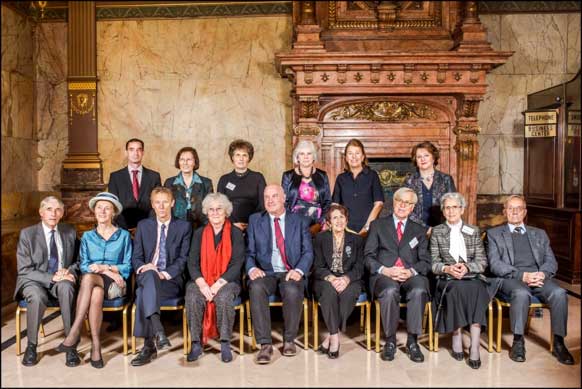
More than a century later: the direct descendants of the participants to the 1911 Solvay Conference in Physics gather in October 2015 in the Hotel Métropole when the European Physical Society bestowed its Historic Site Award to the Hotel. Seated (L-R): Dieter Klingmüller [W. Nernst], Ursula Klingmüller [W. Nernst], Jean-Marie Solvay [E. Solvay], Anna de Haas [H. Lorentz], Yann Lapicque [J.-B. Perrin], Françoise Chapuis [J.-B. Perrin], Paul Siebertz [W. Wien], Maria Rüchardt [W. Wien], Pierre Joliot [M. Curie]. Standing (L-R): Florian Baier [A. Sommerfeld], Monika Baier [A. Sommerfeld], Nathalie Ferrard [A. Einstein], Mary Fowler [E. Rutherford], Catherine Kamerlingh Onnes, Jeanne Kamerlingh Onnes.
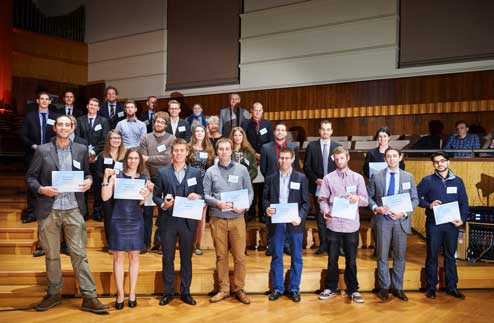
The Solvay Public Event also provides a perfect forum for the ceremony attributing the Solvay Awards honoring outstanding young physicists and chemists for their Master and PhD theses.
Recognizing the profound influence of the Solvay Conferences on physics, the EPS decided to bestow its Historic Site Award to the Hotel Métropole. On October 2015, a commemorating plaque was unveiled in the lobby of the hotel by Christophe Rossel, president of the EPS, and Jef Ongena, president of Belgian Physical Society (BPS). The ceremony was preceded by an academic session.3 The attendance included members of Belgian and European academic and political institutions. Guests of honor were fourteen direct descendants of the Nobel Laureates that were present in 1911, three descendants of Ernest Solvay, and Mr. Wielemans, heir to the family that founded this Brussels landmark hotel.

Christophe Rossel, President of the EPS, and Jef Ongena, President of the BPS, unveiling the EPS Historic Site plaque. It is now exhibited on top of the historic 1911 picture in the lobby of Hotel Métropole.
Alexander Sevrin is a professor at the Free University Brussels (VUB) and founder of the Theoretical High Energy Physics Group whose members investigate aspects of elementary particle physics and cosmology. He is a guest professor at the universities of Antwerp and Leuven. He is the deputy director and the scientific secretary for physics of the International Solvay Institutes for Physics and Chemistry. He sits on the board of directors of several organizations among which the Francqui Foundation, the largest Belgian private science foundation. He is member of the Royal Flemish Academy of Belgium for Science and the Arts.
1 The composition of the Scientific Committee for Physics, currently chaired by David Gross, can be found on the website of the International Solvay Institutes: www.solvayinstitutes.be where a lot of information on the International Solvay Institutes and its activities can be found.
2 For the interested reader, the proceedings make a wonderful read and provide a timely account of some of the most pressing problems in the field: “The Proceedings of the 26th Conference on Physics, Astrophysics and Cosmology”; R. Blandford, D. Gross and A. Sevrin, editors; 2016 World Scientific; 13 + 357 pages.
3 The EPS Historic Site Award celebration was accompanied by the publication of a Special Topic Issue of the European Physical Journal: “The Early Solvay Councils and the Advent of the Quantum Era”; EPJ ST, Vol. 224, September 2015; F. Lambert, F. Berends and M. Eckert, editors.
